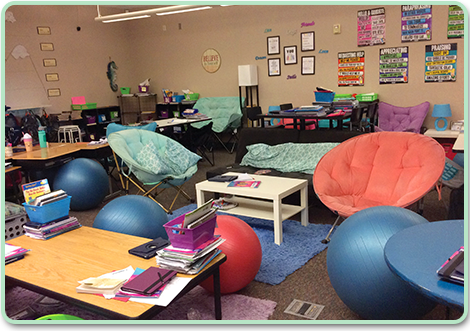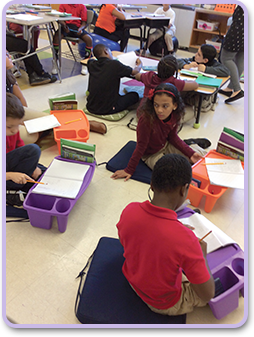Kagan's Articles - FREE Kagan Articles
Articles by Dr. Vern Minor
Flexible Seating
Special Article
Flexible Seating
Is Starbucks the Answer to Engagement?
Dr. Vern Minor
To cite this article: Minor, V. Flexible Seating. Kagan Online Magazine, Issue #61. San Clemente, CA: Kagan Publishing. www.KaganOnline.com

A movement of sorts is infiltrating classrooms across the country—flexible seating. Traditional classroom furniture is being replaced with atypical furniture (e.g., standing tables, yoga mats, couches, work rugs, pillows, yoga balls, bean bags). A call to “ditch the desks” is being voiced by flexible seating advocates around the country. In the words of one classroom teacher, “It’s been my dream to make my 2nd grade classroom look more like a ‘Starbucks for kids’ and less like, well, a classroom” (Delzer, 2015).
The concept is fairly simple. Educators are seeking to design classrooms that reflect trends in the world of work. A number of companies have rethought workplace furniture and their use of space. Kolowich (2016) recently noted shifts that are taking place in the corporate sector.
- Hot Desking
Hot desking simply means no one in the office has an assigned desk or seating area. Instead, when you come in to work in the morning, you can sit anywhere you please—from open tables or desks set up with cables and monitors to more public spaces like couches and chairs. - Movable Desks
Movable desks can be reconfigured to work individually or collaboratively. Desks that fit together like puzzle pieces can be moved, reworked, and reattached as employees see fit. - Overlap Zones
Another alternative to help encourage spontaneous collaboration among employees is designing space to allow for “overlap zones” which make it more likely your employees will run into each other.
Atypical classroom furniture is not a new phenomenon. For years teachers have experimented with alternative seating options in classrooms (e.g., bean bags in learning centers, bathtubs filled with cushions in a reading corner). However, what is somewhat unique about recent developments is the total abandonment of student desks. The idea is “…to create a more comfortable environment that helps students be their best learning selves” (Almer).
There does not appear to be any definitive research to validate that changing furniture will improve student achievement and narrow learning gaps. Nevertheless, a Google search on this topic will reveal a number of brief articles, posts, and blogs by individual teachers who tout reasons to support why they have switched from traditional to nontraditional seating. A few of their beliefs are highlighted below.
- Creates a more comfortable environment
- Produces more positive behavior
- Improves students’ willingness to work
- Generates greater commitment to learning
- Impacts student motivation
- Results in more physical movement in the room
- Prepares students for the real world of work
It is hard to argue with most of these claims. Regardless of what research may or may not say as it relates to improving student learning, common sense would suggest that reclining on a couch in order to read a good book is certainly more comfortable than sitting in a classic student chair-desk combo. The purpose of this article is not to argue the pros or cons of flexible seating. Rather, the focal point of this article is to address a single contention expressed by advocates of flexible seating—student engagement is enhanced.
MISCONCEPTION
The impetus for abandoning student desks in favor of alternative, flexible seating arrangements rests in advocates’ assertion that traditional classroom settings do not engage students. Consider the observations made by these proponents of flexible seating.
To see that some classrooms look the same now as they did 70 years ago is shameful…Our classroom environments should be conducive to open collaboration, communication, creating, and critical thinking. This simply cannot be done when kids are sitting in rows of desks all day (Delzer, 2016). I’ve become convinced that traditional educational settings dull the senses.
I’ve come to the conclusion that desks promote compliance while coffee shop-style seating encourages community building through increased and intentional emphasis on communication and collaboration (Cymerman).

Herein lies the misconception. Clearly, classrooms should be dynamic and interactive, characterized by collaboration, communication, and problem solving. No education reformist in this day and age is promoting a return to the days of rote learning and academic recitation, a time period when students worked in solo fashion. However, to assume that changing furniture is going to impact levels of student engagement is simply not accurate.
The problems associated with traditional classrooms that flexible seating supporters emphasize has little to do with student desks. “Furniture is still just furniture” (Walker). The shortcomings that are noted by teachers who support this movement relate not to furniture but to instruction. They are finding fault with traditional pedagogy (i.e., students sitting passively in rows while teacher talk dominates). Classrooms do, indeed, need to look different than they did 100 years ago. However, changing furniture does not guarantee that a teacher’s instructional practices will change. It is still possible to use traditional strategies in a flexible seating environment. Promoters of flexible seating need to grasp some simple yet profound pedagogical truths.
- Furniture doesn’t ensure all students work collaboratively.
- Furniture doesn’t ensure students do not hide during activities.
- Furniture doesn’t ensure all students are active with the content.
- Furniture doesn’t ensure all students are active with each other.
In short, changing furniture does not ensure all students are engaged. What determines levels of student engagement is the teacher’s pedagogy.
In Kagan Cooperative Learning training, we deal with classroom set up (Kagan, pages 8.13-8.14). A number of varied furniture arrangements are explored (e.g., individual desks, carpet patches on the floor, tables, lecture halls). Type of furniture does not dictate how educators teach. Granted, certain settings create more challenges, and flexible seating would be no exception. Nevertheless, how we teach is not and should not be dictated by furniture. Students can sit in flexible furniture settings and still be disengaged. By the same token, students can sit in traditional desks (though arranged in a nontraditional fashion) and be fully engaged in learning.
TAKEAWAYS
As noted earlier, the purpose of this article is not to discuss whether or not there are merits associated with flexible seating. The intent is to address the misguided claim that flexible seating ensures high levels of student engagement. With that in mind, let me conclude with four important takeaways.
1. Flexible seating is ideal for solo work.
Providing students with the choice of where to work during solo time is ideal. Allowing students to stand, sit, or lie down does not appear to be counterproductive during independent work time. In fact, it may even be helpful in focusing students’ concentration and attention.
2. During direct instruction, team seating guidelines must be followed.
All of the guidelines defined in Chapter 8 of Kagan Cooperative Learning (Kagan) can still be met regardless of where students sit—desks, tables, floors, or bean bags. The beauty of flexible seating is that most furniture is mobile. When it is time for instruction, furniture and/or bodies need to be moved to ensure that team seating guidelines are met, particularly the parameter that notes no student should have his back to the primary teaching location.

3. During direct instruction, grouping of students must be determined by the teacher.
Allowing students to choose where they work every day is espoused by flexible seating proponents. “They choose where they want to sit daily…students may move furniture based on their needs; even laying on the floor is acceptable, and sitting by friends is allowed” (Almer). What educators must understand is that allowing student choice regarding where they sit and with whom they sit is often detrimental to learning.
Heterogeneity by academic achievement (i.e., whether students are grouped in teams or in pairs) cannot be compromised. There are obvious problems with allowing students to self-select teammates or partners during instruction. This is especially critical to learning during guided practice time in lesson design. If students cannot support each other’s learning due to grouping practices, a teacher could inadvertently contribute to achievement gaps. With whom students sit during direct instruction still needs to be determined by the teacher, or the creation of a support system is compromised. Choice in seating can be delegated to students during solo time (i.e., independent practice), but teachers need to define seating parameters during instruction time.
4. Flexible seating and cooperative learning can co-exist.
This does not have to be an either/or proposition. In fact, these two initiatives—flexible seating and cooperative learning—are a perfect fit. A dynamic, responsive, interactive classroom setting is enhanced when both of these factors come together—flexible work space coupled with structured interaction.
Final Thoughts
Whether the trend toward flexible seating will become widespread in schools is yet to be determined. To be honest, I don’t have strong feelings one way or the other. However, what is clearly most important in determining levels of student engagement is not the furniture that fills the classroom—it is the pedagogical strategies a teacher uses. Even advocates of flexible seating acknowledge the importance of pedagogy.
I have a strong conviction that simply swapping out desks for tables doesn’t ensure higher motivation, engagement, or accountability. Redesigning a classroom…is a shift in both structure and teaching philosophy—an entire mindset shift. In fact, teachers need a keen intuition about where the students are working and their level of engagement at all times (Delzer, 2016).
A teacher can effectively engage all students and create a dynamic, robust, highly interactive setting while retaining student desks. The inverse is also true—teachers can have high levels of disengagement in flexible seating arrangements. Furniture does not dictate levels of engagement, student motivation, or the degree to which students move about a classroom. Starbucks is not the answer to student engagement. A teacher’s pedagogy is the key determining factor.
If we hope to create a profession of highly qualified educators, we must embrace changes in instructional practices. Kagan has a long and proud history of helping schools across the country boost academic gains and narrow the achievement gap. It is our hope that we can establish a long-term relationship with your organization as you strive to improve the achievement of all children. If you would like to learn more about the information contained in this document, please feel free to contact either of the educators listed below.
Kagan Contacts

Jackie Minor, Ed.D. |

Vern Minor, Ed.D. |
References
Almer, K. (January 25, 2017). Top 3 Reasons to Use Flexible Seating in the Classroom. Retrieved November 2017 from http://ideas.demco.com/blog/top-3-reasonsuse- flexible-seating-classroom/.
Cymerman, O. (July 29, 2016). Reimagine Your Learning Space: Starbucks Your Classroom! Retrieved November 2017 from www.teachingchannel. org/blog/2016/07/29/starbucks-your-classroom/.
Delzer, S. (October 1, 2015). Why the 21st Century Classroom May Remind You of Starbucks. Retrieved November 2017 from www.edsurge.com/ news/2015-10-01-why-the-21st-century-classroommay- remind-you-of-starbucks.
Delzer, S. (April 22, 2016). Flexible Seating and Student- Centered Classroom Redesign. Retrieved November 2017 from www.edutopia.org/blog/flexibleseating- student-centered-classroom-kayla-delzer.
Kagan, S. & Kagan, M. (2015). Kagan Cooperative Learning. Kagan Publishing: San Clemente, CA, Chapter 8.
Kolowich, L. (March 1, 2016). The Future of the Office: 7 Innovative Ways Companies Are Changing the Workplace. Retrieved November 2017 from https:// blog.hubspot.com/marketing/innovative-companieschanging- workplace.
Walker, T. (September 23, 2016). Farewell Desks, Here Come the ‘Starbucks Classrooms’. Retrieved November 2017 from http://neatoday.org/2016/09/23/ditchingclassroom- desks/.